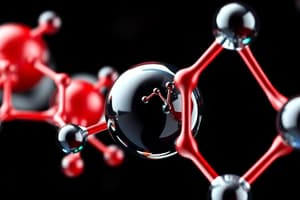Podcast
Questions and Answers
What is the definition of matter?
What is the definition of matter?
- Anything that can be measured.
- Only substances that are solid or liquid.
- Anything that has mass and occupies space. (correct)
- Anything that can be seen and touched.
What type of bond involves the transfer of electrons between atoms?
What type of bond involves the transfer of electrons between atoms?
- Covalent Bond
- Metallic Bond
- Ionic Bond (correct)
- Hydrogen Bond
Which of the following is a characteristic of compounds?
Which of the following is a characteristic of compounds?
- Always exist in a solid state.
- Consist of only one type of atom.
- Formed from two or more elements chemically combined. (correct)
- Can be broken down into simpler substances.
What does the pH scale measure?
What does the pH scale measure?
Which type of reaction is characterized by the breaking down of a compound into simpler substances?
Which type of reaction is characterized by the breaking down of a compound into simpler substances?
What is the Law of Conservation of Mass?
What is the Law of Conservation of Mass?
What is studied in thermochemistry?
What is studied in thermochemistry?
Which of the following correctly describes an acid?
Which of the following correctly describes an acid?
Flashcards are hidden until you start studying
Study Notes
Basic Concepts of Chemistry
-
Matter
- Definition: Anything that has mass and occupies space.
- States: Solid, liquid, gas, and plasma.
-
Atoms
- Definition: The basic unit of matter.
- Structure: Composed of protons (positively charged), neutrons (neutral), and electrons (negatively charged).
-
Elements
- Definition: Pure substances that cannot be broken down into simpler substances.
- Periodic Table: Organizes elements based on atomic number and properties.
-
Compounds
- Definition: Substances formed from two or more elements chemically combined.
- Examples: Water (H2O), sodium chloride (NaCl).
-
Molecules
- Definition: The smallest unit of a compound that retains its chemical properties.
- Types: Homonuclear (same type of atoms) and heteronuclear (different types of atoms).
-
Chemical Bonds
- Types:
- Ionic Bonds: Transfer of electrons between atoms (e.g., NaCl).
- Covalent Bonds: Sharing of electrons between atoms (e.g., H2O).
- Metallic Bonds: Attraction between metal atoms and pooled electrons.
- Types:
-
Chemical Reactions
- Definition: Processes in which substances (reactants) undergo a transformation to form new substances (products).
- Types: Synthesis, decomposition, single replacement, double replacement, combustion.
-
Stoichiometry
- Definition: The calculation of reactants and products in chemical reactions.
- Law of Conservation of Mass: Matter is neither created nor destroyed in a chemical reaction.
-
Acids and Bases
- Acids: Substances that donate protons (H+) in solutions (e.g., hydrochloric acid).
- Bases: Substances that accept protons or donate hydroxide ions (OH-) (e.g., sodium hydroxide).
- pH Scale: Measures the acidity or alkalinity of a solution (0-14 scale).
-
Solutions
- Definition: Homogeneous mixtures of two or more substances.
- Components: Solvent (major component) and solute (minor component).
-
Thermochemistry
- Focus: Study of energy changes during chemical reactions.
- Exothermic Reactions: Release heat; endothermic reactions: absorb heat.
-
Organic Chemistry
- Definition: Study of carbon-containing compounds and their properties.
- Importance: Fundamental for life; includes hydrocarbons, functional groups (e.g., alcohols, acids).
-
Inorganic Chemistry
- Definition: Study of minerals and non-organic compounds.
- Includes: Metals, salts, and coordination compounds.
-
Kinetics and Equilibrium
- Kinetics: Study of the rate of chemical reactions.
- Equilibrium: State where the forward and reverse reactions occur at the same rate, resulting in stable concentrations of reactants and products.
These notes provide foundational knowledge for understanding chemistry and its principles.
Matter
- Anything that has mass and occupies space.
- Exists in four states: solid, liquid, gas, and plasma.
Atoms
- The basic unit of matter.
- Composed of protons (positively charged), neutrons (neutral), and electrons (negatively charged).
Elements
- Pure substances that cannot be broken down into simpler substances.
- Organized on the Periodic Table by atomic number and properties.
Compounds
- Substances formed from two or more elements chemically combined.
- Examples: Water (H2O), sodium chloride (NaCl).
Molecules
- The smallest unit of a compound that retains its chemical properties.
- Can be homonuclear (same type of atoms) or heteronuclear (different types of atoms).
Chemical Bonds
- Ionic: Transfer of electrons between atoms (e.g., NaCl).
- Covalent: Sharing of electrons between atoms (e.g., H2O)
- Metallic: Attraction between metal atoms and pooled electrons.
Chemical Reactions
- Processes where substances (reactants) transform into new substances (products).
- Types: synthesis, decomposition, single replacement, double replacement, combustion.
Stoichiometry
- Calculation of reactants and products in chemical reactions.
- Based on the Law of Conservation of Mass: Matter is neither created nor destroyed in a chemical reaction.
Acids and Bases
- Acids: Substances that donate protons (H+) in solutions (e.g., hydrochloric acid).
- Bases: Substances that accept protons or donate hydroxide ions (OH-) (e.g., sodium hydroxide).
- pH Scale: Measures the acidity or alkalinity of a solution (0-14 scale).
Solutions
- Homogeneous mixtures of two or more substances.
- Composed of a solvent (major component) and a solute (minor component).
Thermochemistry
- Focuses on energy changes during chemical reactions.
- Exothermic: Reactions release heat.
- Endothermic: Reactions absorb heat.
Organic Chemistry
- Study of carbon-containing compounds and their properties.
- Essential for life, covering hydrocarbons and functional groups like alcohols and acids.
Inorganic Chemistry
- Study of minerals and non-organic compounds.
- Includes metals, salts, and coordination compounds.
Kinetics and Equilibrium
- Kinetics: Studies the rate of chemical reactions.
- Equilibrium: A state where the forward and reverse reactions occur at the same rate, resulting in stable concentrations of reactants and products.
Studying That Suits You
Use AI to generate personalized quizzes and flashcards to suit your learning preferences.



